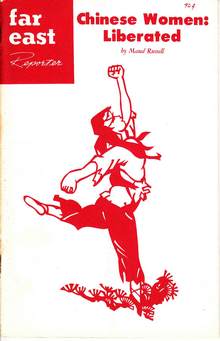History
Maud Russell was the executive director of the Far East Spotlight magazine, which was published from 1946 to 1952 by the Committee for a Democratic Far Eastern Policy (CDFEP). She founded the Far East Reporter in New York City in 1953, and published it until her death in 1989. The newsletter was published on an irregular schedule. Russell had lived in China for 26 years when it was dominated by other countries, and had seen the development of revolutionary nationalism. She used her magazine and speaking tours to explain why the US should recognize the Communist government of China and disengage from Korea, Taiwan and Vietnam. Russell published the views of "experts" on other East and Southeast Asia countries including Vietnam and India, but her main focus was on publishing positive articles about social, political and economic development in China for American readers.
Russell wrote some of the issues herself. Some of the other issues, which were essentially pamphlets on specific topics, were written by well-known people. Russell drew on newspapers and magazines including The New York Times, Far Eastern Economic Review and China Reconstructs, and used material sent by CDFEP supporters in the US and China. Russell had been one of a very small group of "progressive" Westerners in 1930s China, and had returned to the US in 1942. Her regular correspondents from the People's Republic of China included Nan Green, David Crook, Elsie Fairfax-Cholmeley, Israel Epstein, Talitha Gerlach, Rewi Alley and (after 1958) Anna Louise Strong. Often their long letters to Russell were not much more than verbatim copies of Xinhua articles.
In March 1963 the House Un-American Activities Committee (HUC) called on Russell to testify in a closed session. She had been named as a Chinese Communist Party "publicity agent." Russell defended herself vigorously before the committee and in a letter to her subscribers in which she denounced the attempted intimidation by the HUAC. A 1967 description said, "While some readers may be inclined to classify the journal as "Marxist" in content, the publisher, Miss Maud Russell, does not wish to have her views classified as "Marxist". In the 1960s the magazine was praised by the Radical Education Project of the Students for a Democratic Society, which helped publicize her speaking engagements.
During the Cultural Revolution the Epsteins were accused of spying for the West, and from 1968 to 1973 were held in solitary confinement. In May 1971 Russell's old friend Talitha Gerlach wrote from Shanghai to Russell asking her not to defend the imprisoned foreigners against charges of spying, but to remove works by Israel Epstein, his wife Elsie Fairfax-Cholmeley and David Crook from lists of past publications in the Far East Reporter. The last issue of the Far East Reporter appeared in September 1989. In it Russell criticized Deng Xiaoping's Four Modernization policies, which she blamed for the May–June protests.

Mao Zedong, also known as Chairman Mao, was a Chinese communist revolutionary who was the founder of the People's Republic of China (PRC), which he led as the chairman of the Chinese Communist Party from the establishment of the PRC in 1949 until his death in 1976. Ideologically a Marxist–Leninist, his theories, military strategies, and political policies are collectively known as Maoism.

The Cultural Revolution, formally known as the Great Proletarian Cultural Revolution, was a sociopolitical movement in the People's Republic of China (PRC) launched by Mao Zedong in 1966, and lasting until his death in 1976. Its stated goal was to preserve Chinese communism by purging remnants of capitalist and traditional elements from Chinese society. The Revolution marked the effective commanding return of Mao—who was still the Chairman of the Chinese Communist Party (CCP)—to the centre of power, after a period of self-abstention and ceding to less radical leadership in the aftermath of the Mao-led Great Leap Forward debacle and the Great Chinese Famine (1959–1961). The Revolution failed to achieve its main goals.

Maoism, officially called Mao Zedong Thought by the Chinese Communist Party (CCP), is a variety of Marxism–Leninism that Mao Zedong developed to realize a socialist revolution in the agricultural, pre-industrial society of the Republic of China and later the People's Republic of China. The philosophical difference between Maoism and traditional Marxism–Leninism is that a united front of progressive forces in class society would lead the revolutionary vanguard in pre-industrial societies rather than communist revolutionaries alone. This updating and adaptation of Marxism–Leninism to Chinese conditions in which revolutionary praxis is primary and ideological orthodoxy is secondary represents urban Marxism–Leninism adapted to pre-industrial China. Later theoreticians expanded on the idea that Mao had adapted Marxism–Leninism to Chinese conditions, arguing that he had in fact updated it fundamentally and that Maoism could be applied universally throughout the world. This ideology is often referred to as Marxism–Leninism–Maoism to distinguish it from the original ideas of Mao.

The time period in China from the founding of the People's Republic in 1949 until Mao's death in 1976 is commonly known as Maoist China and Red China. The history of the People's Republic of China is often divided distinctly by historians into the Mao era and the post-Mao era. The country's Mao era lasted from the founding of the People's republic on 1 October 1949 to Deng Xiaoping's consolidation of power and policy reversal at the Third Plenum of the 11th Party Congress on 22 December 1978. The Mao era focuses on Mao Zedong's social movements from the early 1950s on, including land reform, the Great Leap Forward and the Cultural Revolution. The Great Chinese Famine, one of the worst famines in human history, occurred during this era.

Rosamond Soong Ch'ing-ling was a Chinese political figure. As the third wife of Sun Yat-sen, then Premier of the Kuomintang and President of the Republic of China, she was often referred to as Madame Sun Yat-sen. She was a member of the Soong family and, together with her siblings, played a prominent role in China's politics prior to and after 1949.

The Sino-Soviet split was the breaking of political relations between the People's Republic of China and the Soviet Union caused by doctrinal divergences that arose from their different interpretations and practical applications of Marxism–Leninism, as influenced by their respective geopolitics during the Cold War of 1947–1991. In the late 1950s and early 1960s, Sino-Soviet debates about the interpretation of orthodox Marxism became specific disputes about the Soviet Union's policies of national de-Stalinization and international peaceful coexistence with the Western Bloc, which Chinese founding father Mao Zedong decried as revisionism. Against that ideological background, China took a belligerent stance towards the Western world, and publicly rejected the Soviet Union's policy of peaceful coexistence between the Western Bloc and Eastern Bloc. In addition, Beijing resented the Soviet Union's growing ties with India due to factors such as the Sino-Indian border dispute, and Moscow feared that Mao was too nonchalant about the horrors of nuclear warfare.

Rewi Alley was a New Zealand-born writer and political activist. A member of the Chinese Communist Party, he dedicated 60 years of his life to the cause and was a key figure in the establishment of Chinese Industrial Cooperatives and technical training schools, including the Peili Vocational Institute. Alley was a prolific writer about 20th century China, and especially the communist revolution. He also translated numerous Chinese poems.

Chen Boda, was a Chinese Communist journalist, professor and political theorist who rose to power as the chief interpreter of Maoism in the first 20 years of the People's Republic of China. Chen became a close associate of Mao Zedong in Yan'an, during the late 1930s, drafting speeches and theoretical essays and directing propaganda.
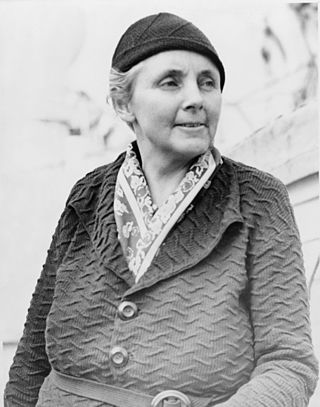
Anna Louise Strong was an American journalist and activist, best known for her reporting on and support for communist movements in the Soviet Union and the People's Republic of China. She wrote over 30 books and varied articles.

Sidney Shapiro was an American-born Chinese lawyer, translator, actor and writer who lived in China from 1947 to 2014. He lived in Beijing for more than 50 years and eventually became a member of the National Committee of the Chinese People's Political Consultative Conference. He was one of very few naturalized citizens of the PRC.

Israel Epstein was a Polish-born Chinese journalist and author. He was one of the few foreign-born Chinese citizens of non-Chinese origin to become a member of the Chinese Communist Party.
David Crook was a prominent British communist who spent most of his life teaching in China. A committed Marxist from 1931, he joined the International Brigades to fight against the Spanish nationalists in the Spanish Civil War (1936–1939). After being wounded in combat, he was recruited by the NKVD, the Soviet secret police, and was sent to China during the Second Sino-Japanese War (1937–1945). There he met and married his wife, Isabel, a teacher and social activist. Following the Second World War and the Chinese Civil War, the couple stayed in China and taught English.
In the People's Republic of China since 1967, the terms "ultra-left" and "left communist" refers to political theory and practice self-defined as further "left" than that of the central Maoist leaders at the height of the Great Proletarian Cultural Revolution (GPCR). The terms are also used retroactively to describe some early 20th century Chinese anarchist orientations. As a slur, the Chinese Communist Party (CCP) has used the term "ultra-left" more broadly to denounce any orientation it considers further "left" than the party line. According to the latter usage, the CCP Central Committee denounced in 1978 as "ultra-left" the line of Mao Zedong from 1956 until his death in 1976. This article refers only to 1) the self-defined ultra-left of the GPCR; and 2) more recent theoretical trends drawing inspiration from the GPCR ultra-left, China's anarchist legacy and international "left communist" traditions.
Chinese Industrial Cooperatives (CICs) were organisations established in China during the Second Sino-Japanese War to support China's war effort by organizing small-scale grassroots industrial and economic development. The movement was led through the Chinese Industrial Cooperative Association founded in 1938 by foreign and Chinese activists. Its international arm the International Committee for the Promotion of Chinese Industrial Cooperatives was founded in 1939 in Hong Kong to promote cooperatives in China.

Liu Shaoqi was a Chinese revolutionary, politician, and theorist. He was Chairman of the NPC Standing Committee from 1954 to 1959, First Vice Chairman of the Chinese Communist Party from 1956 to 1966 and Chairman of the People's Republic of China, the de jure head of state, from 1959 to 1968, during which he implemented policies of economic reconstruction in China.
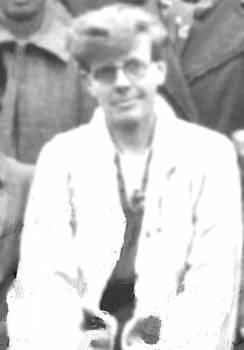
Maud Muriel Russell was an American social worker, educator, and writer. She is best remembered for her work as a social and political activist for the YWCA in China from 1917 to 1943. Returning to New York, she served as the executive director of the Committee for a Democratic Far Eastern Policy from 1946 to 1951 and contributed to the journal Far East Reporter from 1953 until her death from lung cancer in 1989.
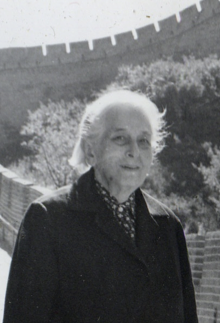
Talitha A. Gerlach was an American YWCA worker who spent most of her life as a social worker in Shanghai, China, where she died. She received various awards from the Shanghai and Chinese governments.
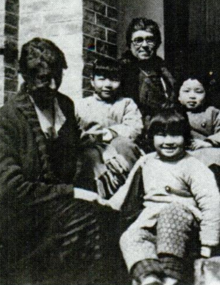
Lillian Katherine Haass was a YWCA worker in Shanghai, China, between 1914 and 1945. She led efforts to educate Chinese women to become leaders among industrial workers.
The Committee for a Democratic Far Eastern Policy (CDFEP) was an organization that was active in 1945–52 in opposing US support for the Kuomintang government in China.
The Shengwulian or Sheng-wu-lien was a radical ultra-left group formed in 1967 during the Cultural Revolution. The rebel group became known for its opposition to local authorities installed by Beijing and for creatively re-interpreting the Cultural Revolution's official doctrine, becoming active during a period when the political trends of the Cultural Revolution were moving away from mass political mobilization.
